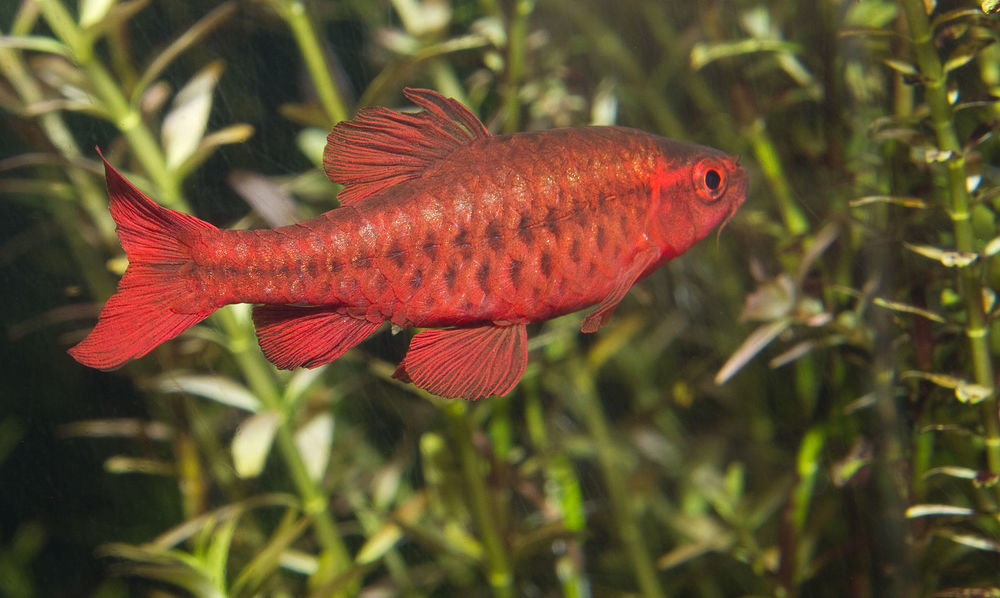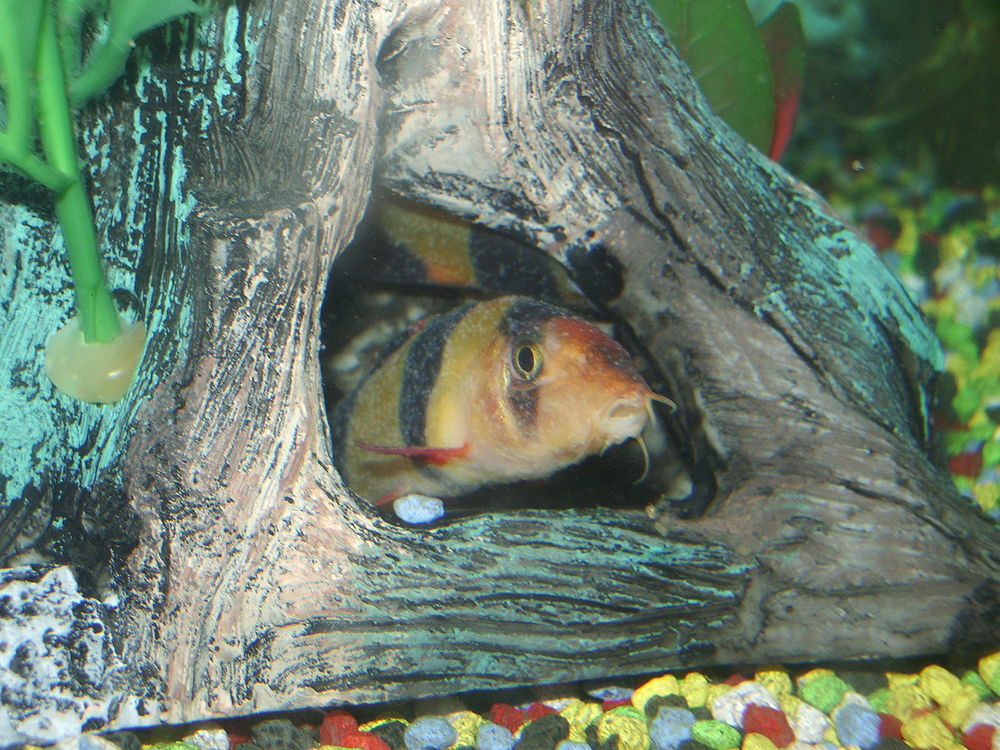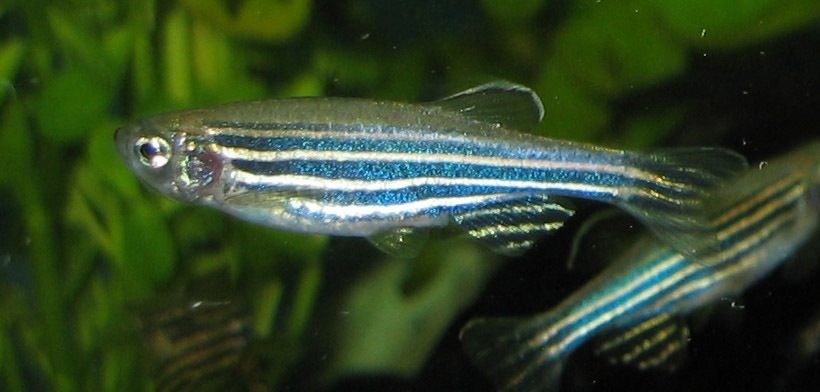Many aquarists strive to create the most colorful or beautiful aquarium they can. Typically, this means keeping a wide variety of bright fish, exotic plants, and fun decorations.
With so many different fish species out there, it can be hard to pick which to keep. Luckily, freshwater schooling fish are a great option for both novice aquarists and experts alike!
Let’s take a look at what schooling aquarium fish are, as well as the best schooling fish species for your aquarium. By the end, you’ll have a better understanding of which to call your own!
Contents
What Are Schooling Fish?
Schooling fish are large groups of fish that stick together for a variety of reasons. Technically, schooling is when these groups all swim in the same direction. Most of the time, they are shoaling (or sticking together for social reasons).
Being in a school presents a wide array of benefits for every fish. For example, schools protect fish from being eaten by much larger predators. A group of dozens or even hundreds of fish will deter a predator from attacking them, instead going on to attack a fish swimming all alone.
Fish that want to join a school will generally try to find larger schools comprised of fish from their own species, or at least shoal-mates that are similar in size and appearance to themselves. This is because the more daring predator will single out any shoal member that looks different from the others to chase and eat, in a phenomenon known as the oddity effect. This effect may be why most schools of fish are homogenized.
Swimming so close together can also reduce friction and allow the fish to conserve their energy. Living in a group also makes it easier to locate food and even a mate among the school. The larger numbers certainly make it easier to protect their eggs during spawning season.
About 1/4 of all fish species will shoal all their lives, while about 1/2 will shoal for only a portion of their lives. Usually, smaller fish participate in schools, though larger fish will sometimes school together as well.
Best Schooling Fish
When stocking an aquarium, remember to choose only one top-dwelling species, one species that swims in the middle of the tank, and one that settles in the bottom. This will prevent them from fighting with one another. However, if your aquarium is smaller than 15 gallons, it’s best to house only one or two species.
Let’s look at 10 of the best schooling fish species for your tank.
Cardinal Tetras
Cardinal tetras are peaceful, sociable, and work best in schools of six or more. You should place them in tanks that are already well-established to prevent any sudden changes to the water, which would otherwise shock them.

They prefer dim lighting, so live, floating plants in the tank will help keep it gentle for them. They will also need ample hiding places, so be sure to furnish your tank with plenty of decorations.
Water Requirements
- Soft.
- Acidic (as in below 6.0 pH).
- Between 76 to 81 degrees Fahrenheit.
- Low mineral content.
- At least 20 gallons’ worth of space.
Tank Mates
Cardinal tetras do well with other small and medium-sized community fish, but do not keep them with fish known to eat smaller, brighter fish than themselves.
They’re top to mid-dwellers, so danios, rasboras, and other tetras will make the best tank mates for them.
Clown Loaches
Clown loaches tend to be large schooling fish, growing up to eight inches in length. As such, it’s best to house them in a tank that can hold up to 100 gallons or more. They do best in schools of about five or more.
These fish can be quite active during the day, which makes the larger tank all the more necessary. This ample room should also be filled with plenty of hiding places, as this species can be rather shy in nature.
Finally, they are quite sensitive, so be sure to keep their water extra clean, so as to avoid stressing them out.
Water Requirements
- Soft.
- Acidic (anywhere between 6.0 to 6.5 pH).
- Between 75 to 81 degrees Fahrenheit.
Tank Mates
Clown loaches are very peaceful bottom-dwellers that rarely have issues with tank mates. Any species that hovers above them will suffice.
Rummynose Tetras
Rummynose tetras will thrive in schools of about six or more; however, on occasion, they may hide alone if they feel threatened.
They are also highly sensitive to both temperature and pH fluctuations, so be sure to keep their water conditions as stable as you can.

Water Requirements
- Slightly acidic (between 5.5 to 7.0 pH).
- 72 to 77 degrees Fahrenheit.
- 25 gallons or more.
Tank Mates
These tetras are mid-dwellers, so pairing them with top- or bottom-dwelling fish should be fine. Large, peaceful invertebrates, as well as adult dwarf shrimp will prove excellent tank mates for these fish. However, adult rummynose tetras may eat smaller dwarf shrimp and their fry, so be very wary before adding these shrimp to your tetra tank.
Cherry Barbs
These small schooling fish are great for beginning aquarists, due to their overall hardiness and easy care — provided you keep them in tanks of up to six or more cherry barbs, of course.
They can tolerate a wide range of water parameters. However, you should keep them in dim lighting, as this will mimic their natural habitat and keep them feeling both safe and comfortable. Having an ample number of plants for them to hide in will also help darken the tank.

Water Requirements
- 6.0 to 8.0 pH.
- 73 to 81 degrees Fahrenheit.
- 20 to 30 gallons.
Tank Mates
They are usually intimidated by other fish and may turn aggressive towards other species and their own. To prevent this, you should keep the correct ratio of males to females: about 1:2 respectively. This will reduce their territorial instincts and boost their more docile nature.
Red Rainbowfish
Among fish-keepers, the red rainbowfish are one of the most popular subspecies of rainbowfish. They tend to grow up to six inches in adulthood and can be quite active, so their schools will definitely need a large tank to roam around in. They do best in schools of between six to ten rainbowfish.
They are very sensitive to poor water conditions. As such, keeping their tanks in top condition is a must when caring for this species.

Water Requirements
- 7.0 to 8.0 pH.
- 75 to 82 degrees Fahrenheit.
- 75 or more gallons.
Tank Mates
Though they are a generally peaceful species, their fast movements may bother smaller or slow-moving fish in the tank. The best tank mates for these fish include other similarly-sized rainbowfish, characins, danios, barbs, and catfish such as Corydoras.
Harlequin Rasboras

Harlequin rasboras are have peaceful temperaments and a hardiness that makes them one of the more popular schooling fish on the market. These fish become stressed out when kept alone, so it is best to house them in schools of six to eight.
These fish thrive in blackwater biotopes, though they will also adapt to other water conditions, so long as your aquarium is properly cycled. You can add Indian almond leaves to your tank to mimic their natural habitat, though offering other aquatic plants they can hide in will work fine.
Water Requirements
- Soft.
- Slightly acidic (between 5.5 to 7.0 pH).
- 72 to 80 degrees Fahrenheit.
- 10 or more gallons.
Tank Mates
Harlequin rasboras tend to dwell in the top and middle layers of the tank, so they will pair best with bottom-dwelling fish. They will also be comfortable sharing the tank with other species of rasbora, and may even school with them, too.
White Cloud Minnows

The white cloud minnow is named after the White Cloud Mountain region in China, where they were first discovered. They are extremely tiny fish, and should be kept in schools of around 20 to 30, so you can see them flitting about your tank. Their size also makes them far more affordable than tetras and other similar schooling fish.
Novices may be especially drawn to this species, due to their hardiness and high activity levels.
Water Requirements
- Soft (make sure the water is never too hard).
- Slightly acidic (between 6.0 to 7.0 pH).
- 60 to 72 degrees Fahrenheit.
- 10 gallons.
Tank Mates
These minnows like to swim at the top and middle sections of the tank, so keeping them with some peaceful bottom-dwellers is best.
They also do great in hill-stream-like setups, with loaches and other species from similar waters. Just avoid keeping them with bigger fish that are prone to eating small fish.
Hatchet Dadio
Despite the “hatchet” part of its name, the hachet dadio is not part of the hatchet fish group of tetras or characins. These small fish tend to naturally school together, and will work best in schools of around 30 in number.
They need to be housed in a spacious, well-established tank that has both rooted and floating plants. This will provide them with ample hiding places to keep them calm and feeling safe.

When stressed (or even when bored), these fish may attempt to jump out of their tank. Therefore, it is very important to fix a tightly-fitted hood to the top of your aquarium.
Dadio are quite sensitive to poor water quality and any quick changes in water chemistry. As such, it’s essential to carry out more frequent partial water changes, rather than one large change at the end of every few weeks or so. This species is not the best for novice aquarists, since that may be considered a hassle.
Water Requirements
- Soft.
- Slightly acidic (between 6.0 to 7.0).
- 15 or more gallons.
Tank Mates
Larger, peaceful invertebrates make the best tank mates for hachet dadio, though pairing them with dwarf shrimp will work just fine. That is, if you provide them with several plants and cover to work with.
It is best to introduce the dwarf shrimp to the aquarium before your hatchet dadio, so they can become properly settled.
Pygmy Corydoras
Pygmy cories are basically tiny catfish. These fish thrive in schools of no less than six to eight. Any smaller, and these fish start to become anxious.

Their tanks should be full of smooth substrate, which they can’t accidentally ingest. This is because pygmy cories dwell at the bottom of the tank and like to dig for their food.
Water Requirements
- 6.5 to 7.5 pH.
- 72 to 79 degrees Fahrenheit.
- 10 or more gallons.
Tank Mates
Because these are small schooling fish, they can easily be intimidated or even targeted by larger fish. It’s best to keep them with other dwarf fish, shrimp, or snails.
Zebra Danios
Zebra danios are incredibly hardy and active fish, making them the perfect choice for novice aquarists. Zebra danios work best in schools of five or more, though they are prone to breeding quickly. Keep this in mind before you purchase a small tank.
They are very active fish, and, as such, will grow easily bored without any decorations or plants to stimulate them. Other than the live plants they will need to darken their tank, these fish do not need much maintenance and are quite inexpensive to keep.
Water Requirements
- Slightly acidic (between 6.5 to 7.2 pH).
- 65 to 77 degrees Fahrenheit.
- 25 or more gallons.
Tank Mates
These fish tend to grow bored very easily, so they may start to nip at the fins of other fish around them to entertain themselves.
Because of this, you should house them with other danios, tetras, and barbs – not fish that have long fins, like angelfish or catfish.
Conclusion
Schooling fish are some of the most visually dynamic species you can keep in your aquarium. Their bright colors and darting movements can easily draw onlookers’ eyes to your tank, who may then compliment how utterly beautiful your set-up is!
Now that you have a better idea of the most popular schooling fish to keep, you can make an informed decision when starting your own lively aquarium.
What are your favorite schooling fish?




